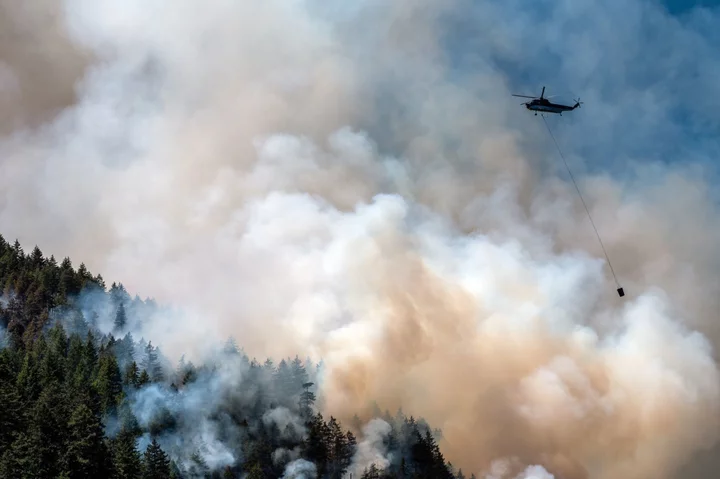When the greenhouse gases released from Canada’s 2023 wildfires are eventually tallied, they will be at least double the emissions from all other sectors of the nation’s economy combined, according to a top government scientist who has spent three decades measuring the carbon footprint of forests.
The 2023 emissions are “off the scale” compared to previous years, said Werner Kurz, a senior research scientist with Natural Resources Canada. Kurz’s team helped create a carbon budget model for Canada’s forestry sector which is used by governments and scientists around the world.
A full reckoning won’t be published until 2025. But as of July 18, a preliminary estimate suggests roughly 1,420 million metric tons of carbon dioxide equivalent (CO2e) have been released from the fires so far, across Canada’s managed and unmanaged forests, Kurz said. By comparison, emissions from all other sectors of the country’s economy totaled 670 million metric tons of C02e in 2021, the last year for which full-year figures are available.
This season’s fires have been unprecedented both in terms of pollution — smoke blanketed major North American cities, shut down airports and crossed the Atlantic Ocean to Europe — and the staggering scale of territory burned. Some 11.7 million hectares and counting have ignited, an area larger than Ohio.
However, the most far-reaching impact, only just starting to be understood, is the scale of emissions.
Kurz’s figure of 1,420 million metric tons includes both managed and unmanaged forests. Even limiting the scope to managed forests, the amount of carbon being burned is exponentially higher than in years past going back to 1990, and roughly equivalent to the annual emissions of Canada in 2021.
Read More: Canada’s Record Wildfire Season Set to Worsen as Heat Builds
Canada’s vast boreal forests have long been carbon sinks that absorb the planet-warming gas. This year, continuing the recent trend, the country’s managed forest will be a source of CO2, releasing more than it absorbs.
Kurz’s estimate only covers direct emissions — that is, the GHGs released from burning trees as well as living and dead organic matter in and on the soil. But roughly the same amount of indirect emissions will be released when the dead remnants of scorched trees decompose in coming years, he says.
Meanwhile, the fire season is barely half over and doesn’t yet show signs of easing.
The high environmental toll of the fires makes extinguishing them as quickly as possible a matter of global concern. But in higher North American latitudes, that’s easier said than done.
In early June, firefighters began constructing a 20-foot-wide, 8-mile-long fireguard inside the southern section of Wood Buffalo National Park, which straddles the border between Alberta and the Northwest Territories. The task took six days, three bulldozers and two excavators. The crew used the heavy equipment to clear trees and scrape back a 5-foot-deep layer of organic material known as “duff” down to bare sand. It was one of hundreds of fireguards being constructed across the country: slow, hot, exhausting work.
Less than a month later, fire had jumped the barrier and the personnel were headed back to try again, said Katie Ellsworth, a plan section chief with Parks Canada, currently deployed at Wood Buffalo, who helps in the preparation for fighting fires.
Typically those fire guards would have held, but little about this fire season has been typical, she said. “We’re watching things burn that, by every textbook and every TED talk and published paper, suggest that they should not burn — and yet they are.”
The fires are “aggressive, they’re in the crowns of the trees, they’re moving from treetop to treetop,” said Ellsworth. Previously burned areas — which she likens to the charred, tough-to-ignite logs of an old campfire — are catching fire again. “We’re looking at old burned areas from 2014 and 2015 and 2018 that, by all accounts and everything we know, should slow the passage of the fire, and they’re not holding.”
Climate change is altering the way fires behave, experts say, as extended periods of record-breaking heat, drought, and high winds create ideal conditions for wildfires to reach abnormal intensity. Most of the outbreaks in Canada are the result of lightning strikes, rather than preventable causes like campfires or sparks from electrical wires (though those also occur). More intense storms can mean many more lightning strikes on a single day, often across remote areas that are hundreds or even thousands of kilometers from airstrips or roads.
Read More: US, Canada Wildfire Risk Raised by Rapid Melting of Arctic Ice
The world’s boreal zone circles the Northern Hemisphere in a vast band that begins just south of the Arctic Circle. It includes lakes, wetlands and other naturally treeless areas like mountain tops but also one-third of Earth’s forests. In Canada, three-quarters of forests are in the boreal zone, covering 307 million hectares, an area larger than Argentina. A vast cache of biodiversity, it contains half the country’s species of birds and unique mammals like woodland caribou and is home to many of Canada’s Indigenous communities.
But this critically important ecosystem doesn’t respond as well to some of the standard fire measures used in other parts of the world. In contrast to the southwestern US, for example, where fires often occur in a mix of trees and grassland, fire retardant dropped from planes may not reach flames on the ground because it’s caught by the thick layer of underbrush and smaller trees often found beneath the boreal canopy. Also, most of the trees in Canada’s Northern forests are coniferous — spruce and pine — and highly flammable.
It’s also vast and remote. By necessity, firefighting efforts in northern Canada, as well as Alaska, have concentrated on populated areas or areas with key infrastructure, putting out fires when possible and redirecting others that threaten to head that way. The rest are mostly allowed to burn themselves out. When that happens, the value of the forest as a carbon sink changes to a carbon liability.
Accurately measuring the full carbon footprint of global wildfires is tricky. A number of variables — including the depth and composition of organic matter burned, the size and species of dominant trees and what happens to the forest after the fire — make modeling a challenge. Human activity, whether tree planting, harvesting, or controlled burns, adds further complexity, removing and adding carbon to the equations.
Carbon-rich peat, for example, releases roughly 25% more emissions than regular boreal forest when burned and can be very difficult to extinguish, smoldering underground and resurfacing months later. It can also hold a greater volume of organic material because it is so deep below ground, although normally the lowest sections don’t ignite.
In northern latitudes, thawing permafrost is another knock-on effect of wildfires, said Brendan Rogers, an associate scientist at the Woodwell Climate Research Center in Falmouth, Massachusetts. Permafrost doesn’t burn — it is too full of frozen water — but the organic material on top of it can, removing an important layer of insulation and exposing the permafrost to more heat. “The permafrost wouldn’t exist except for the organic matter and the vegetation,” he said. “When you burn that off, what you tend to get in the years after a fire is that soil warms, the permafrost thaws, and you get deeper active layers,” which means a thinner layer of permafrost remains frozen year-round.
Thawing permafrost releases its own GHGs, including methane, and collapsing permafrost can create lakes that dissolve and release even more methane. Meanwhile peatlands — which exist across much of Canada, including in boreal forests and on permafrost — may be left more flammable after a fire because they are drier, he said.
Rogers’ research suggests the world is dramatically underestimating the carbon impact of wildfires. Climate trajectories and carbon budgets are based on Earth system models that include the impact of fire. However, many of those global models don’t include direct emissions from burned organic material under the surface, Rogers says, which his research indicates represents 80% to 90% of fire emissions in boreal forests, nor do they include the indirect effects of fire on permafrost. As a result, projections by leading bodies, including the Intergovernmental Panel on Climate Change, he said, are “quite conservative.”
Looking at the amount of carbon the world can burn and still meet Paris Agreement targets, “10 to 20% of those remaining [carbon] budgets, we’re estimating, will be eaten up by the combination of intensifying fire regimes and permafrost thaw, and the interactions between the two,” he said, referring to the findings of a soon-to-be-published paper.
That makes preventing wildfires a matter of global urgency, especially in vast areas of sequestered carbon. The fuel load of a forest can be lightened to make it more fire resistant, by clearing away brush, harvesting small trees or doing a controlled burn. Vast forests can be broken up by clearing trees to create areas of grassland, while highly flammable trees, like black spruce, can be replaced with different native species. More resources can be focused on putting out small fires in remote areas quickly, rather than allowing them to spread as is the norm.
Unfortunately, most of these strategies are very expensive to deploy on a large scale and may also be less effective as northern climates warm.
“Carbon content, or risk of carbon emissions, is at the moment not a criterion for setting firefighting priorities,” said Kurz. “In the northern boreal there are few people, there are few roads, there are few airports. There is just not the infrastructure to effectively fight fires. And so while it would be really good to do this from a climate perspective, the actual feasibility of doing so is going to be very challenging.”









